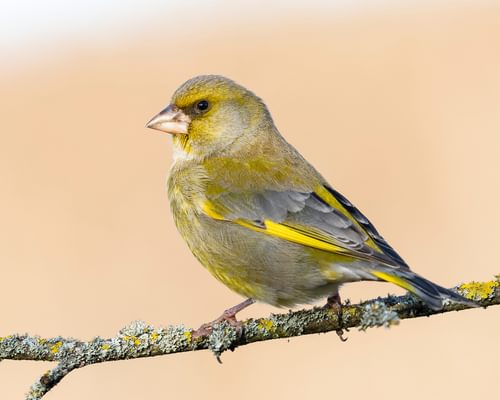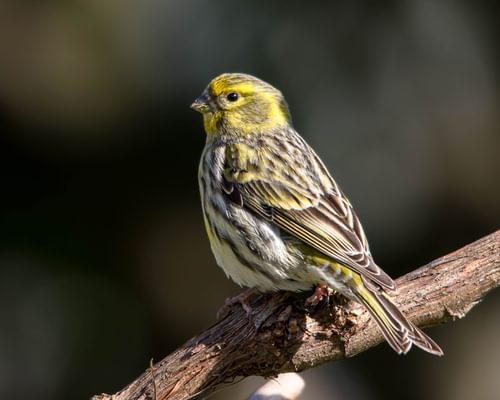Eurasian Siskin
Least ConcernSpinus spinus
Visual Identification
Appearance
The Eurasian Siskin is a small, lively finch with distinctive yellow-green plumage. Males feature bright yellow patches on their wings and tails, contrasting with a black cap and chin. Their bodies are streaked with dark markings on a greenish-yellow background.
Females are slightly smaller and more subdued, with an overall greener appearance and heavier streaking. They lack the black cap of males but retain the yellow wing bars. Juveniles resemble females but with even heavier streaking.
The Siskin is most often confused with the Greenfinch, which is about 50% larger.
Size
Length
11cm to 12.5cm
Wingspan
20cm to 23cm
Weight
10g to 18g
Habitat and Distribution
Habitats
Woodland
Garden
Wetland
Coastal
Urban
Farmland
Grassland
Desert
Tundra
Rainforest
Mountain
Savanna
Distribution
Eurasian Siskins inhabit coniferous and mixed forests across Europe and Asia, from the British Isles to Japan. They show a particular affinity for spruce, pine, fir woodlands, and areas with birch and alder trees.
During winter, many birds move southward or to lower elevations. In the UK, they become more widespread, frequenting gardens and parks in search of food. Some populations in southern Europe are largely sedentary.
Elevation Range
Up to 2,000 meters
Climate zones
Temperate, Subarctic
Distribution Map
This map gives you a rough idea of where you might spot a Eurasian Siskin. The coloured areas show countries where these birds have been seen.
A few things to keep in mind:
- Birds might not be everywhere in the coloured areas, for example, they may be present around the coast of that country
- Where birds live can change with seasons and available food
- This map is quite simple - it doesn't show exact locations
We're working on making our maps even better! Soon, we hope to show you:
- More detailed maps for bigger countries, including state and region
- How birds move around during different seasons
Distribution by Region
Behaviour and Ecology
Bird Attributes
This feature is in beta. We'd love your feedback to improve it!
Share your thoughtsBird Attributes Explained
Our bird attributes system rates various aspects of a bird's capabilities on a scale of 0-100, based on data from field observations, scientific studies, and expert knowledge.
Attribute Categories:
- Agility: Manoeuvrability, speed, and grace in flight or movement.
- Strength: Physical power, often correlating with size and hunting abilities.
- Adaptability: Ability to thrive in various environments or changing conditions.
- Aggressiveness: Territorial behaviour and assertiveness, particularly during breeding seasons.
- Endurance: Stamina, often seen in migration patterns or foraging behaviours.
Understanding the Ratings:
- 0-20: Very Low
- 21-40: Low
- 41-60: Average
- 61-80: High
- 81-100: Very High
Remember, these attributes are relative to other bird species and don't necessarily indicate superiority.
Hover over the icon next to each attribute for more information.
Tap the icon next to each attribute for more information.
Agility
Reflects the bird's manoeuvrability, speed, and grace in flight or movement.
The Eurasian Siskin displays remarkable agility, being highly acrobatic and often seen hanging upside down on branches whilst foraging. Their ability to perform elaborate flight displays during courtship further demonstrates their nimbleness.
Strength
Indicates the bird's physical power, often correlating with size and hunting abilities.
As a small finch, the Eurasian Siskin possesses limited strength relative to larger birds. However, their ability to extract seeds from cones and hang in various positions whilst feeding indicates a degree of strength appropriate for their size.
Adaptability
Represents the bird's ability to thrive in various environments or changing conditions.
Eurasian Siskins show good adaptability, inhabiting various woodland types across Europe and Asia. Their ability to adjust to different elevations (up to 2,000 metres) and shift their range during winter demonstrates flexibility in response to environmental changes.
Aggressiveness
Measures the bird's territorial behaviour and assertiveness, particularly during breeding seasons.
Generally, Eurasian Siskins are not known for aggressive behaviour. Their social nature, often found in small flocks, suggests a relatively peaceful disposition. However, like most birds, they may display some territoriality during breeding season.
Endurance
Reflects the bird's stamina, often seen in migration patterns or foraging behaviours.
Whilst not long-distance migrants, Eurasian Siskins undertake partial migrations and can move considerable distances in search of food. Their ability to survive in various climates, from temperate to subarctic, indicates decent endurance for a small bird.
Diet
Eurasian Siskins primarily feed on small seeds, particularly those of alder, birch, and conifer trees. They will sometimes take some fruit and insects.
They use their fine, pointed beaks to extract seeds from cones and catkins. In gardens, they readily visit feeders, showing a preference for niger seeds and sunflower hearts.
Behaviour
Eurasian Siskins are highly acrobatic, often seen hanging upside down on tree branches or seed heads while foraging. They are social birds, typically found in small flocks, especially outside the breeding season.
During courtship, males perform elaborate flight displays, fluttering with spread wings and tails to attract females.
Vocalisation
Eurasian Siskins are known for their loud, cheerful, twittering calls. Their song is a rapid series of trills and warbles, often delivered in flight. The most common call is a distinctive 'tilu' or 'tluee', frequently repeated.
When in flocks, they produce a constant chatter of soft 'tswee' notes. They sing in flight or from a prominent perch so that their voice will carry.
Nesting & Breeding
Breeding season for Eurasian Siskins typically begins in April. Males attract females with melodious songs and aerial displays. Pairs form monogamous bonds for the breeding season.
Nests are usually built high in coniferous trees, well-concealed among the branches. The female constructs a small cup-shaped nest using twigs, moss, and lichen, lined with feathers and plant down.
The female lays 3-5 pale blue eggs with reddish-brown spots. Incubation lasts about 12-14 days, primarily by the female. Both parents feed the chicks, which fledge after 13-15 days but remain dependent on their parents for several more weeks.
Lifespan
The Eurasian Siskin typically lives for 2 to 3 years, with a maximum recorded lifespan of 13.5 years.
Like all birds, lifespan can be affected by factors including predation, habitat quality, disease, and access to food sources.
Conservation and Status
Global Conservation Status
While currently listed as Least Concern, Eurasian Siskins face threats from habitat loss due to deforestation and climate change.
Conservation efforts focus on protecting coniferous forests and promoting sustainable forestry practices. In some areas, winter feeding in gardens helps support populations during harsh weather.
Birdwatching Tips
- Look for Siskins in coniferous forests or mixed woodlands
- Listen for their distinctive twittering calls and chattering song
- Watch for their acrobatic feeding behaviour on alder and birch trees
- In the UK, check garden feeders during the winter months
- Observe flocking behaviour with other finch species
Additional Information
Quick Facts
Other names:
Siskin
Family:
FringillidaePredators
Did You Know?
- Eurasian Siskins can open their beaks wider than most finches, allowing them to extract seeds from cones more efficiently.
- Their population can fluctuate dramatically from year to year, depending on seed availability.
- In some European countries, Siskins were once popular as caged birds due to their melodious songs.
Was this bird profile helpful?
Your feedback helps us improve our content
Thanks for your feedback!
Your input helps us improve our content.
Community Experience
Community Ratings
No ratings yet - be the first to rate this bird!
Latest Community Reviews
No reviews yet
Sign in to be the first to review
Community Reviews
Create Your Free Account Welcome Back!
Join our community to rate birds and share your experiences. Creating an account is completely free and only takes a minute. Sign in to your account to rate birds and share your experiences with our community.
Your information is secure and will never be shared.
By creating an account, you agree to our Privacy Policy.
Similar Birds
References
- 2 3
website: BirdLife International. 2017. Spinus spinus (amended version of 2016 assessment). The IUCN Red List of Threatened Species 2017: e.T22720354A111126041.
View source - 4
report, 2015: EBCC
- 1
website, 2010: Fransson et al., EURING list of longevity records for European birds
View source



